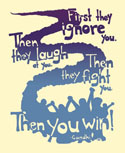Then You Win!
by Betsy Gandhi’s cheerful description of the progress of campaigns and movements appears on several products we sell — mugs, t-shirts, posters, and note cards. If only it were that simple in real life! I would guess the Mahatma said this with a twinkle in his eye.
Gandhi’s cheerful description of the progress of campaigns and movements appears on several products we sell — mugs, t-shirts, posters, and note cards. If only it were that simple in real life! I would guess the Mahatma said this with a twinkle in his eye.
Anyone who’s done any grassroots organizing knows that campaigns are not guaranteed a win at all! And often, in the interests of achieving something, the goals of the campaign get whittled down considerably — leaving more to do later on. “Winning” often doesn’t look like you thought it would in the beginning. Poor Gandhi did, in fact, see India become free from British colonial rule, and also saw the bloody partition of India and Pakistan. Not the win he set out to achieve!
So, what’s the point in putting out a slogan that’s at best over-simplified? To me it’s valuable to note that there are stages in a campaign, and that the Powers That Be are highly unlikely to respond graciously to being challenged.
At first, when we raise an issue and get ignored, our determination may well increase. It’s a surprise and an irritant to be laughed at — although being ridiculed often helps us deepen our analysis and refine our message, too. Encountering real resistance can come as quite a shock to activists who hope that an injustice exists only because of ignorance, and that “the public” or the powerholders will change their ways as a result of education.
It’s in the fighting stage that things get dicey, because we are tempted to fight each other over our tactics as well as fighting the opponent! Good examples are the furor over property destruction that accompanies practically every major demonstration, and the charges of “selling out” which often go along with attempts to work out a solution. Of course, the powerholders are only too happy to further the divisions among us, and a good hunk of strategizing lies in figuring out how we can divide them faster than they can divide us!
We increase our chances of winning, of course, with a mixture of solidarity, creative actions that the opponents never anticipated, steady education (for ourselves and for “the public”), winning converts among the powerholders, and — frankly — pressure tactics. Gandhi himself used plenty of pressure tactics, as well as milder forms of nonviolence such as building alternative institutions.
So, although far from complete in itself, Gandhi’s catchy formulation of the path of a campaign keeps the bigger picture in front of us, and helps us console ourselves when things don’t seem to be moving very quickly, or going very well.
